
Deposition Date
2021-10-24
Release Date
2022-06-08
Last Version Date
2023-11-29
Entry Detail
PDB ID:
7VRS
Keywords:
Title:
The complex of Acyltransferase and Acyl Carrier Protein Domains from module 9 of Salinomycin Polyketide Synthase
Biological Source:
Source Organism:
Streptomyces albus subsp. albus (Taxon ID: 67257)
Host Organism:
Method Details:
Experimental Method:
Resolution:
2.60 Å
R-Value Free:
0.22
R-Value Work:
0.18
R-Value Observed:
0.18
Space Group:
P 2 2 21


